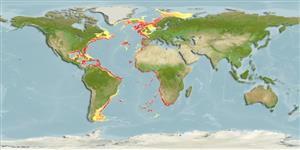Environment: milieu / climate zone / depth range / distribution range
экология
морской батидемерсальный; пределы глубины 45 - 1300 m (Ref. 5951), usually 300 - 823 m (Ref. 5951). Deep-water
Western Atlantic: coasts of Canada and United States, Gulf of Mexico, Caribbean, and the coast of South America to Rio de Janeiro, Brazil; in the east, from the Gulf of Guinea to Angola.
Size / Вес / Возраст
Maturity: Lm ? range ? - ? cm
Max length : 39.4 cm TL самец/пол неопределен; (Ref. 5951); common length : 14.5 cm SL самец/пол неопределен; (Ref. 4490)
колючие лучи спинного плавника (общее число): 0; членистые (мягкие) лучи спинного плавника (общее число): 5-7; колючие лучи анального плавника 0; членистые (мягкие) лучи анального плавника: 4; позвонки: 18 - 19. Tubercles (its form of scales) have ridges radiating from the apical spine; these ridges heavily edged with spinules, especially the largest tubercles; thus, tubercles appear to be multi-spined. Vertebral count usually 18. Cephalic lateral-line counts: subopercular 4-6, preopercular, 1-3. Tail lateral-line counts 9-13. Usual number of dorsal fin rays 6, pectoral fin rays 14-15; vertebrae 18. Color differences observed between eastern and western Atlantic populations; specimens from Gulf of Guinea often have reticulate markings on the dorsal surface of the body, usually vague (occasionally strong), which are not seen in western Atlantic material. Fins, except dorsal, usually have tubercles on bases of rays. Pectoral fins slender, sturdy relative to most other species; pelvic fins slender (Ref. 40826).
Found on mud or sand-mud bottoms (Ref. 26999). Benthic adults are luminous (Ref. 40826). Feeds chiefly on polychaetes; bottom-living amphipods, bivalve molluscs, brittle stars, starfishes and sea spiders (Ref. 5951).
Life cycle and mating behavior
половая зрелость | размножение | нерест | икра | Fecundity | личинки
Bradbury, M.G., 1999. A review of the fish genus Dibranchus with descriptions of new species and a new genus, Solocisquama (Lophiiformes, Ogcocephalidae). Proc. Calif. Acad. Sci. 51(5):259-310. (Ref. 40826)
Статус Красного Списка МСОП (Ref. 130435)
Угроза для людей
Harmless
Использование человеком
рыболовство: коммерческий
дополнительная информация
ссылкиаквакультура (рыбоводство)особенности рыбоводствастепень растяжениягенетикаElectrophoresesнаследуемостьболезниобработкаNutrientsMass conversion
соавторыизображенияStamps, Coins Misc.звукиCiguateraскоростьтип плаванияжаберная областьOtolithsмозгзрение
инструменты
Специальные отчеты
Скачать в формате XML
ресурсы в Интернет
Estimates based on models
Preferred temperature (Ref.
123201): 3.2 - 13.9, mean 8.2 °C (based on 646 cells).
Phylogenetic diversity index (Ref.
82804): PD
50 = 0.5001 [Uniqueness, from 0.5 = low to 2.0 = high].
Bayesian length-weight: a=0.01479 (0.00517 - 0.04233), b=2.93 (2.69 - 3.18), in cm total length, based on LWR estimates for this (Sub)family-body shape (Ref.
93245).
Trophic level (Ref.
69278): 3.4 ±0.42 se; based on food items.
устойчивость к внешним воздействиям (Ref.
120179): низкий, минимальное время удвоения популяции 4.5-14 лет (Preliminary K or Fecundity.).
Fishing Vulnerability (Ref.
59153): Low to moderate vulnerability (29 of 100).
